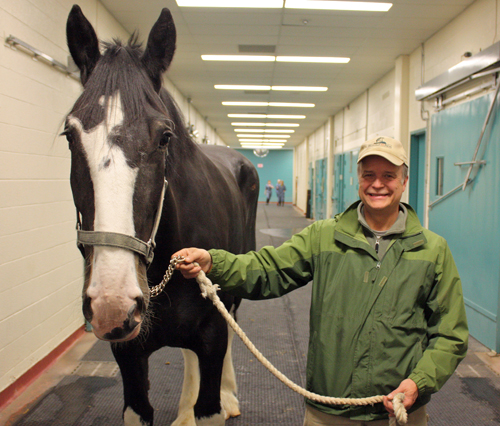Jane Dawkins

Kim Smith was unsure what was wrong with his seven-year-old Shire mare, Rose. By this past January, the former champion show horse had become unstable, walking wobbly-kneed and often unable to get up on her own.
At first, Smith, owner of Westwind Farm in Burlington, Ont., thought the problem was the extra weight of her pregnancy. Rose had been inseminated seven months earlier and was carrying about 100 kilograms over her regular weight of 850 kilograms.
But as the problem continued, Smith started to worry it was something worse — maybe “shivers.”
This chronic nervous or neuromuscular syndrome is considered uncommon today and mainly affects draft horse breeds. It develops gradually and is not easily noticed. Severely affected horses might hesitate to lie down, lose body condition and appear to age. The debilitating disease may result in early death from profound weakness, muscle wasting, discomfort and incapacitation because of muscle cramping.
More worrisome to Smith, no effective treatment or cure exists.
He turned to the University of Guelph’s Ontario Veterinary College (OVC).
“I brought Rose to the Ontario Veterinary College because I was in a situation where I couldn’t manage her at home,” says Smith. “I was certain that she and her foal were in great danger.”
Tests by OVC veterinarian Dan Kenney in OVC’s Health Sciences Centre showed that Rose didn’t have shivers. Instead, Kenney determined that the horse had contracted equine protozoal myeloencephalitis (EPM).
He says EPM affects the nervous system and is difficult to diagnose.
“The symptoms can be very similar to shivers and can often be mistaken for wobbler syndrome, the neurological form of herpes virus infection, rabies, West Nile virus or other equine viral encephalitis diseases — for example, Eastern and Western equine encephalitis.”
Most often caused by a parasite named Sarcocystis neurona, EPM is carried in the feces of opossums and other scavenger animals. Ingested by the host animal, the parasite moves from the intestine into the bloodstream and then into the central nervous system.
EPM can cripple a horse slowly or quickly; the parasite and associated inflammation can cause permanent damage. Rose was diagnosed and treated early. Early detection means more successful treatment and prevention of further damage, says Kenney.
No vaccine exists for the disease. Kenney says owners can take preventive measures, including developing wildlife management systems in stables and on their property.
A specialist in large-animal internal medicine, he has a long-standing interest in EPM and has written and spoken about the disorder.
Referring to the Large-Animal Clinic, Smith says, “The team at OVC has been nothing less than fabulous. With their excellence in equine health and expertise in neonatal care, I was hopeful we would get to the bottom of Rose’s health issue and, of course, protect her unborn foal.”
While at OVC, Rose delivered that foal. Smith named the newborn Westwind Ken Danby after the late Ken Danby, a Guelph-based artist and lifelong friend of Smith’s. “I like to name my horses after Canadian artists. Once the foal was born, I knew it was going to be Ken Danby. I miss him very much. He was a great and generous man who also had a love of horses.”
Smith hopes to show Westwind Ken Danby this fall at an international draft horse show in Michigan.